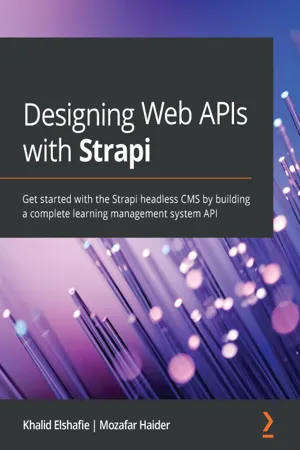
- 310 pages
- English
- ePUB (mobile friendly)
- Available on iOS & Android
Designing Web APIs with Strapi
About this book
Leverage the power of Strapi to build self-hosted, customizable, and performant content APIsKey Features• Discover how Strapi can help you build APIs quickly and focus on your products and features• Learn how to put Strapi into practice by implementing it in real-world scenarios• Understand how to use Strapi's powerful features to customize your APIsBook DescriptionStrapi is a Node.js-based, flexible, open-source headless CMS with an integrated admin panel that anyone can use and helps save API development time. APIs built with Strapi can be consumed using REST or GraphQL from any client. With this book, you'll take a hands-on approach to exploring the capabilities of the Strapi platform and creating a custom API from scratch.This book will help JavaScript developers to put their knowledge to work by guiding them through building powerful backend APIs. You'll see how to effortlessly create content structures that can be customized according to your needs, and gain insights into how to write, edit, and manage your content seamlessly with Strapi. As you progress through the chapters, you'll discover a wide range of Strapi features, as well as understand how to add complex features to the API such as user authentication, data sorting, and pagination. You'll not only learn how to find and use existing plugins from the open-source community but also build your own plugins with custom functionality with the Strapi plugin API and add them to the admin panel. Finally, you'll learn how to deploy the API to Heroku and AWS.By the end of this book, you'll be able to build powerful, scalable, and secure APIs using Strapi.What you will learn• Explore Strapi and understand how it works• Define content types to build APIs quickly and efficiently• Understand authentication and authorization in Strapi• Create production-ready APIs with Strapi• Deploy the Strapi API to various environments, including Heroku and AWS• Use best practices to run the Strapi API in production• Sync permissions to access the API between multiple environments• Write basic tests for API utilities as well as the endpointWho this book is forThis book is for backend and frontend JavaScript developers. Experienced API developers will learn a new, fast, and flexible way of building APIs, while frontend developers will be able to take a step toward becoming full-stack developers by learning how to leverage Strapi for building APIs quickly. Basic knowledge of JavaScript and REST API concepts is assumed.
Frequently asked questions
- Essential is ideal for learners and professionals who enjoy exploring a wide range of subjects. Access the Essential Library with 800,000+ trusted titles and best-sellers across business, personal growth, and the humanities. Includes unlimited reading time and Standard Read Aloud voice.
- Complete: Perfect for advanced learners and researchers needing full, unrestricted access. Unlock 1.4M+ books across hundreds of subjects, including academic and specialized titles. The Complete Plan also includes advanced features like Premium Read Aloud and Research Assistant.
Please note we cannot support devices running on iOS 13 and Android 7 or earlier. Learn more about using the app.
Information
Section 1: Understanding Strapi
- Chapter 1, An Introduction to Strapi
- Chapter 2, Building Our First API
- Chapter 3, Strapi Content-Types
- Chapter 4, An Overview of the Strapi Admin Panel
Chapter 1: An Introduction to Strapi
- What is Strapi?
- Why use Strapi? (The benefits of Strapi)
- Preparing the development environment
- Creating a Strapi application
- Understanding server scripts
What is Strapi?

Why use Strapi? (The benefits of Strapi)
Open-source Node.js
Database-agnostic
Customizable (extendable)
RESTful and GraphQL
Users and permissions
Table of contents
- Designing Web APIs with Strapi
- Contributors
- About the authors
- About the reviewer
- Preface
- Section 1: Understanding Strapi
- Chapter 1: An Introduction to Strapi
- Chapter 2: Building Our First API
- Chapter 3: Strapi Content-Types
- Chapter 4: An Overview of the Strapi Admin Panel
- Section 2: Diving Deeper into Strapi
- Chapter 5: Customizing Our API
- Chapter 6: Dealing with Content
- Chapter 7: Authentication and Authorization in Strapi
- Chapter 8: Using and Building Plugins
- Section 3: Running Strapi in Production
- Chapter 9: Production-Ready Applications
- Chapter 10: Deploying Strapi
- Chapter 11: Testing the Strapi API
- Appendix: Connecting a React App to Strapi
- Other Books You May Enjoy